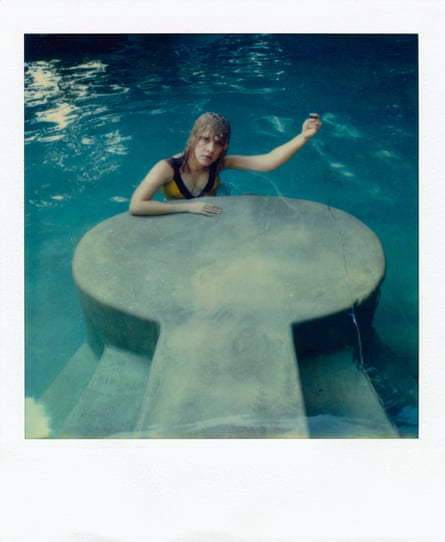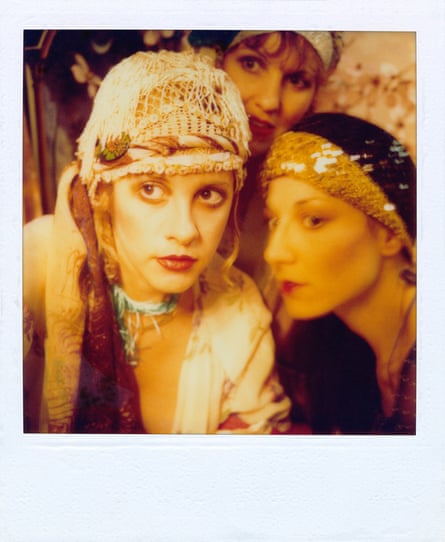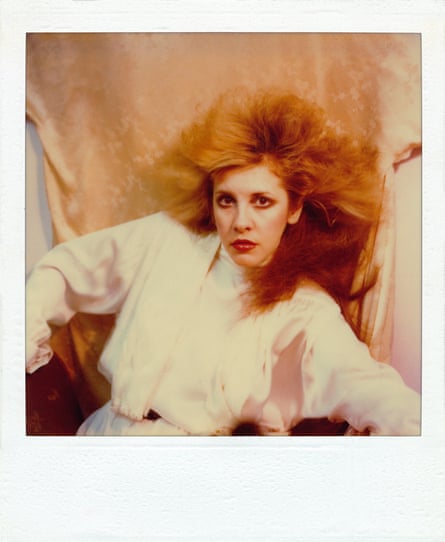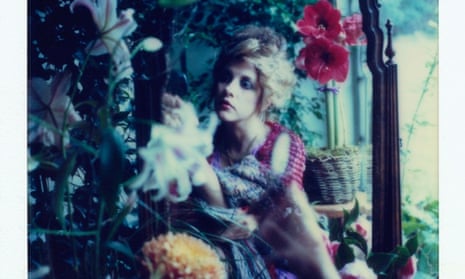A collection of self-portrait Polaroids shot by Fleetwood Mac legend Stevie Nicks will go on display at a New York City gallery next month after languishing in a shoebox for decades.
“Some people don’t sleep at night. I’m one of those people,” Nicks said in a statement about the photographs. “I would begin after midnight and go until 4 or 5 in the morning. I stopped at sunrise, like a vampire. I never really thought anyone would ever see these pictures.”
The exhibit, 24 Karat Gold, curated by Eurythmics guitarist and Stevie Nicks collaborator Dave Stewart, accompanies a new album from Nicks, which will be released under the same title. The album, like the portraits, is a time capsule unearthed: the songs were written and demo-ed between 1969 and 1987, but re-recorded in recent months.
The Guardian spoke to Peter Blachley, owner of the Morrison Hotel Gallery, where the exhibit takes place next month, about the show.
Tell us a little about your gallery – the Morrison Hotel Gallery – which I understand specialises in photographs of and by musicians.
PB: The gallery itself has been specific to fine art music photograph for many years. We started in 2000-2001 doing little shows on the west coast just to do the photography of Henry Diltz, who was one of our partners, and shot covers for the Eagles, the Doors, Crosby, Stills & Nash, Jackson Browne.
When we went to New York we knew that was the city we wanted to be based in. We went to three different locations in Soho before we finally found our permanent gallery. It’s evolved to where today we have over 120 photographers that we represent and they’re all music-based and probably the best in the world.

The Stevie Nicks show is curated by Dave Stewart, who produced an album of Stevie’s. You also have a music industry background. How did that play into how the exhibit came about?
Dave came to us a few years ago with his own photographs, and I saw what he was doing with Mick Jagger and Tom Petty and I thought: jeez, here’s a recording artist who at the same time has such an eye and a technical ability for creating photography. This is a natural for the Morrison Hotel Gallery.
Fast forward a few years later, when Dave has been working with Stevie, and he sees these self-portrait Polaroids that she did and said: look, we should really do an exhibit with these, I know a gallery in New York. So we decided to do the Stevie Nicks show based on what we saw as some very creative work done at a certain point in her life.
She said that she took the pictures to “learn how to be a photographer”. To me, many of the images look very sophisticated, like the work of a pro. Is she just being modest?
I think she was really being her own muse in terms of how she wanted to see herself. She sort of opened up this wonderful treasure chest of clothing and furniture and accessories, and all the things that she would have had around her to create these little worlds of fashion, and how she saw herself.
From a photographic point of view, if you look at those Polaroids, at the photographs, of course this is before digital and today it’s a lot easier to take digital self-portraits because the cameras auto-focus, they auto-color, they do everything. Even those early Polaroid cameras that she was using with a cord – in the shot where she’s in the swimming pool you can see the cord in her hand as she’s clicking the shot – in every other shot she’s disguised it very well.
So I think even though she was learning and experimenting, she was very sophisticated in her knowledge of composition, her knowledge of framing, her knowledge of color. Because the shots are just beautifully art directed.

I couldn’t help but notice a disparity in how the show was billed only as ‘self-portraits’, but a lot of media coverage has called the photographs ‘selfies’. Did you cut out the word on purpose? Do you have an opinion on it?
What we’re trying to project is a woman who was, as I say, filled with whatever muse was going on. She had to do these self-portraits because back in 1975, that’s what they were. And that’s what she was going for. Now we’re in 2014 and everybody has phones and ‘selfie’ has become the thing that everybody does.
I felt from a gallery point of view, probably the most credible and authentic way to approach this was ‘self-portrait’ because that’s what they were called in 1975 and that’s what she did when she was doing them. But in 2014, I knew that once the media got this we were going to see ‘selfie’ everywhere. And actually, fair enough, because I feel that, yeah, OK, maybe Stevie Nicks created the original selfie portraits. Wonderful! That doesn’t bother me at all.
I want to talk about nostalgia, which the show packs heavily, and which paradoxically makes it feel current because of the Instagram feel of the photos.
Here’s the difference. Because if they were really selfies they would forever live on your iPhone. You would look at them that way. But Nash Editions, which is one of the greatest fine art photography labs in the country, created much larger, Iris digital prints that are museum quality. These things are going to be 6ft x 7ft in many cases. When you walk into the show itself and you see these, the word ‘selfie’ is going to kind of go away, and the word ‘fine art’ is going to come into your head because they’re going to be impressive when they’re that large. The colors, her expressions, even her fingernails – the color of her fingernails, or the rings she was wearing, or the bracelets. It’s going to become so much more front and center than how you would see it in a small format.

How is the accompanying album incorporated into the exhibit? How did the album come out to be in tandem with this show? Does it play into the show?
There are two factors at play: the album is certainly one of them. It’s a new Stevie Nicks album, however, it’s a lot of cuts and things she had done previously. So it’s sort of a retrospective for her musically in the same way the self-portraits are. 24-Karat Gold, meaning we just mined these nuggets that we found in Stevie’s archive. We’re bringing them forward.
But the other element, the second element, is her touring with Fleetwood Mac and now that Christine McVie is in the band you’ve got the original band back. It’s like Stevie’s kind of coming full circle in a way, but at the same time we feel that with the new album and the gallery showing, it’s sort of bringing out more elements to her than we’ve ever seen before. I think it’s really smart on her part to do that.

Stevie Nicks was recently on what turned out to be a massively popular episode of American Horror Story, and all this is now happening. What do you put down to her enduring success? Why do people find her image so bewitching?
I think Stevie has a particular appeal with women, that is different than her appeal with men. I think men, when their first album came out, we just said about Stevie: “Wow, what a gorgeous woman.” I think women took it deeper. I think there was some connection that Stevie made with women. I don’t really know what that connection was but I think a lot of woman became really fanatical about her, but in a good way.
Usually, our gallery appeals to men. Most rock’n’roll photographs of men are heroic, and men are drawn to that. So many times they’ll come in our gallery and their girlfriends or their wives will come over to me and go: “I want to get that for his birthday, how much is it?”
So I was up in the gallery the other day and a man came in and said: “I came here because I want to get a Stevie Nicks photo for my wife. It’s our anniversary and she loves Stevie” – like we were talking about – “She’s fanatical about her. She speaks to her.” You know, all these things. Like, “She’s gotta have one of these.” And I said, “Sir, we will make that happen for her” and I’m gonna tell you, as a guy I’ve never seen this before.
That’s never happened before? That’s amazing.
No! It really is. And we’re seeing that trend with Stevie’s show. And that’s different than we’ve had with others.
24 Karat Gold opens to the public on 10 October at the Morrison Hotel Gallery at 201 Mulberry Street in New York City, before moving down the road to its showroom at 116 Prince Street. Her album, 24 Karat Gold: Songs from the Vault, is out in the US on 7 October.

Comments (…)
Sign in or create your Guardian account to join the discussion